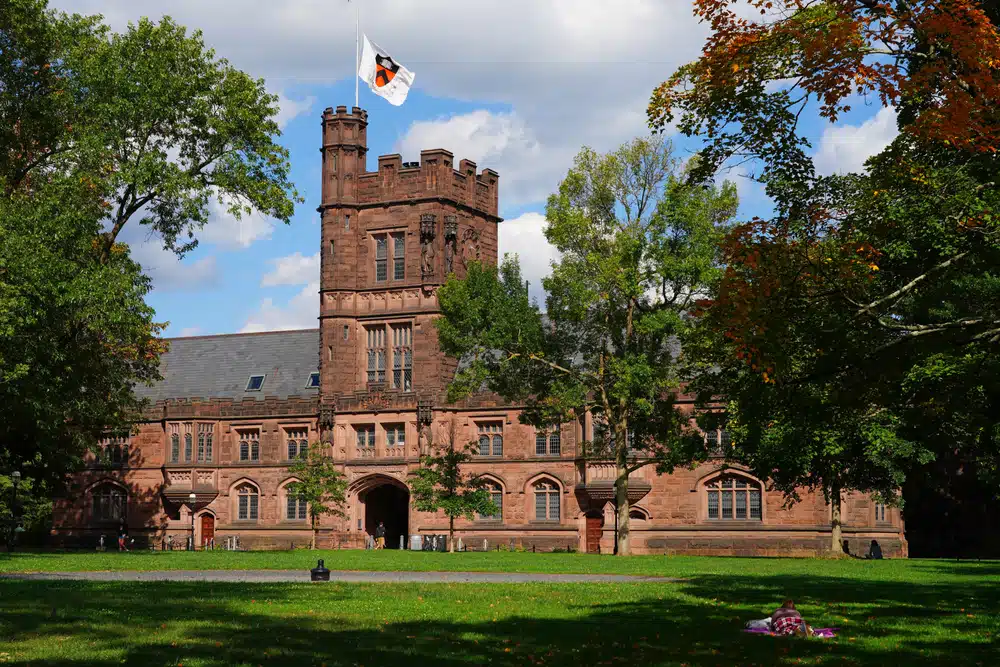Exploring Financial Aid Opportunities at Princeton University
Princeton University is a prestigious institution known for its commitment to providing financial aid opportunities to its students. Understanding the basics of financial aid is essential for prospective students considering applying to Princeton. This article will delve into the different types of financial aid available, Princeton University’s financial aid policies, scholarships and grants offered, work-study programs, and the application process.
Understanding the Basics of Financial Aid
Attending college can be a dream come true for many students, but the financial burden can often be overwhelming. Thankfully, various forms of assistance are available to help alleviate this burden. This assistance is known as financial aid, and it comes in different forms, such as scholarships, grants, loans, and work-study programs.
What is Financial Aid?
Financial aid refers to the support provided to students to help them afford the cost of attending college. It is designed to bridge the gap between the cost of education and what students and their families can pay out of pocket. Without financial aid, many students would find it extremely challenging, if not impossible, to pursue higher education.
Scholarships are one of the most sought-after forms of financial aid. They are essentially free money that does not need to be repaid. Scholarships can be awarded based on factors such as academic achievement, community involvement, or specific talents and interests. They are often highly competitive, but the rewards can be significant.
Grants, like scholarships, do not need to be repaid. They are typically awarded based on financial need, and eligibility is determined by factors such as family income, assets, and the cost of attendance. Grants can come from various sources, including the federal government, state governments, and private organizations.
On the other hand, loans are borrowed funds that need to be repaid with interest. They can come from the federal government, private lenders, or the college. Loans can be a valuable resource for students who need financial assistance, but it’s essential to carefully consider the terms and conditions before borrowing.
Work-study programs allow students to earn money to help pay for their education. These programs typically offer part-time employment on campus or with approved off-campus employers. The income earned through work-study covers educational expenses, allowing students to gain valuable work experience while reducing their reliance on loans.
Types of Financial Aid
Like many other institutions, Princeton University offers both need-based and merit-based financial aid to its students. Need-based assistance considers a student’s family income, assets, and other economic factors to determine the amount of aid they may be eligible to receive. This type of aid is specifically designed to assist students who demonstrate financial need.
Merit-based aid, on the other hand, is awarded based on a student’s exceptional academic, athletic, or artistic achievements. This type of aid recognizes and rewards students with outstanding talent or dedication in a particular area. Merit-based scholarships are often highly competitive and can significantly attract top-performing students to a college or university.
It’s important to note that financial aid packages can vary significantly from one institution to another. Each college or university has its policies and criteria for awarding aid. Therefore, it’s essential for students and their families to thoroughly research and understand the financial aid options available to them at each institution they are considering.
Financial aid can significantly impact a student’s ability to pursue higher education. It can open doors that would otherwise remain closed and provide opportunities for personal and academic growth. Understanding the basics of financial aid is the first step in navigating the complex world of college financing and making informed decisions about one’s educational future.
Princeton University’s Financial Aid Policies
Eligibility Criteria for Financial Aid at Princeton
Princeton University is committed to making education affordable for students from all backgrounds. The university considers various factors when determining a student’s eligibility for financial aid, including their family’s income and assets, the number of family members in college, and any extraordinary expenses. It is important to note that financial aid packages can vary from student to student based on these factors.
Princeton University understands that the cost of attending college can be a significant burden for many families. To alleviate this burden, the university has established generous financial aid policies to assist those needing it most. Considering many factors, Princeton ensures that financial aid is distributed fairly and equitably among its student body.
In addition to income and assets, Princeton also considers the number of family members in college. This recognizes that families with multiple students in college may face tremendous financial strain. By viewing this factor, Princeton ensures that aid is allocated in a way that reflects the unique circumstances of each student’s family.
Furthermore, Princeton recognizes that some families may have extraordinary expenses that can impact their ability to pay for college. Whether it’s medical bills, caring for a disabled family member, or other unforeseen circumstances, the university considers these expenses when evaluating a student’s financial need. This ensures that aid is provided to those who face additional economic challenges.
How Princeton University Allocates Financial Aid
Princeton University utilizes a need-based approach to allocate financial aid. By assessing a student’s demonstrated financial need, the university aims to create an equitable assistance distribution among its students. The university’s financial aid office carefully evaluates each student’s financial circumstances before determining the aid package that best suits their needs.
Princeton’s need-based approach ensures that financial aid is allocated to those who require it the most. The university considers various factors when assessing financial needs, including income, assets, and family circumstances. This comprehensive evaluation allows Princeton to provide aid packages that address the unique financial situations of its students.
Moreover, Princeton’s financial aid office understands that financial circumstances can change over time. To account for this, the university has a policy of annually reassessing a student’s financial need. This ensures that aid packages are adjusted accordingly, considering changes in a student’s family income, assets, or other relevant factors.
Princeton University is committed to providing a transparent and accessible financial aid process. The university’s financial aid office is available to assist students and their families throughout the application and evaluation process. Whether it’s answering questions, providing guidance, or offering support, the financial aid office is dedicated to helping students navigate the complexities of financial aid.
By utilizing a need-based approach and considering a wide range of factors, Princeton University strives to create a financial aid program that is fair, equitable, and responsive to the needs of its diverse student body. Through its commitment to affordability, Princeton ensures that all students, regardless of their financial circumstances, can pursue a world-class education.
Scholarships and Grants at Princeton University
Princeton University, renowned for its commitment to academic excellence and fostering a diverse and talented student body, offers a range of scholarships and grants to support students in their educational journey. These financial aids recognize exceptional talent and achievement and ensure that financial barriers do not hinder deserving students from accessing a world-class education.
Merit-Based Scholarships
Princeton University takes great pride in acknowledging and rewarding students who have demonstrated outstanding academic prowess and exceptional accomplishments in their extracurricular activities. The university offers a plethora of merit-based scholarships that serve as a testament to these remarkable individuals’ dedication and hard work.
These highly competitive scholarships attract the best and brightest minds from around the world. The rigorous evaluation process ensures that only the most deserving students are selected, guaranteeing that the recipients of these scholarships genuinely embody the spirit of academic excellence that Princeton University upholds.
Princeton University recognizes and supports these students’ achievements by providing merit-based scholarships. It nurtures their potential, empowering them to make a lasting impact in their chosen fields and contribute to the betterment of society.
Need-Based Grants
Princeton University firmly believes that financial circumstances should never hinder a student’s ability to pursue higher education. Need-based grants are available to ensure that talented individuals from all walks of life can access the unparalleled educational opportunities offered by the university.
These grants are specifically designed to address the financial needs of students who require assistance to attend Princeton University. The university understands that each student’s financial circumstances are unique. As such, the grant amounts are determined individually, considering factors such as family income, assets, and other financial obligations.
By offering need-based grants, Princeton University aims to create an inclusive and diverse community of scholars where students from various socioeconomic backgrounds can come together to learn, grow, and thrive. These grants alleviate the financial burden and provide a sense of support and encouragement to students, enabling them to fully immerse themselves in their academic pursuits and make the most of their time at Princeton.
Princeton University ensures that all students have equal opportunities to excel academically and achieve their goals regardless of their financial circumstances. Through a combination of merit-based scholarships and need-based grants, the university continues to uphold its mission of providing a transformative educational experience to students who have the potential to shape the future.
Work-Study Programs at Princeton University
How Work-Study Programs Work
Princeton University provides work-study programs that allow students to earn money to help cover educational expenses. These programs offer part-time employment opportunities on-campus, providing students with valuable work experience while earning income that can be used towards their educational costs. The university has many work-study options available to accommodate various skills and interests.
When students participate in work-study programs at Princeton University, they can work in various departments and offices across campus. For example, students may work in the library, assisting with research projects and helping other students find their needed resources. Others may work in the admissions office, supporting the staff and assisting with recruitment events. There are also opportunities to work in academic departments, helping professors with administrative tasks or conducting research.
One of the unique aspects of the work-study programs at Princeton University is the emphasis on mentorship. Students participating in these programs are paired with experienced staff members who serve as mentors throughout their work-study experience. These mentors provide guidance, support, and advice, helping students navigate the workplace and develop essential skills for their future careers.
Benefits of Participating in Work-Study Programs
Participating in work-study programs can provide numerous benefits to students. In addition to earning money, work-study programs allow students to gain practical skills, build professional networks, and enhance their resumes. Moreover, working on-campus provides convenience, as students can easily balance their academic commitments and work responsibilities.
By participating in work-study programs, students can develop critical transferable skills that employers highly value. These skills include time management, communication, teamwork, and problem-solving. Through their work-study experience, students learn how to effectively manage their time and prioritize tasks, essential skills in any professional setting.
Furthermore, work-study programs provide students with the opportunity to build professional networks. By working closely with staff members and interacting with other students, students can establish connections that may benefit their future careers. These connections can lead to internships, job opportunities, and mentorship relationships, significantly enhancing a student’s professional development.
Lastly, participating in work-study programs allows students to enhance their resumes. Employers value practical work experience, and having a work-study position on a resume can demonstrate a student’s commitment, work ethic, and ability to balance multiple responsibilities. This can give students a competitive edge when applying for internships, graduate school, or full-time employment after graduation.
Applying for Financial Aid at Princeton University
Required Documents for Financial Aid Application
Applying for financial aid at Princeton University involves submitting several essential documents. These typically include the Free Application for Federal Student Aid (FAFSA), the CSS Profile, federal tax returns, and any additional supporting documents requested by the university. It is crucial to carefully review the requirements and deadlines to ensure a complete and timely application.
Deadlines and Important Dates
Princeton University has specific deadlines for submitting financial aid applications. It is essential for prospective students to stay informed of these deadlines and any additional important dates related to the financial aid process. Missing the deadlines may result in a delay or forfeiture of financial aid opportunities.
Exploring financial aid opportunities at Princeton University is a crucial step for prospective students. The university’s commitment to making education affordable and its various financial aid programs make it an attractive option for students from diverse backgrounds. By understanding the basics of financial aid, including the different types available and the application process, prospective applicants can better navigate the financial aspect of their college journey.
If you want to discuss the matter to a greater extent or inquire about college admissions, look no further! Our experts here at AdmissionSight can help you! Here at AdmissionSight, we have over a decade’s worth of experience guiding students through the competitive admissions process to get accepted to the top universities in the world. Feel free to set up an appointment today to book your initial consultation.









































